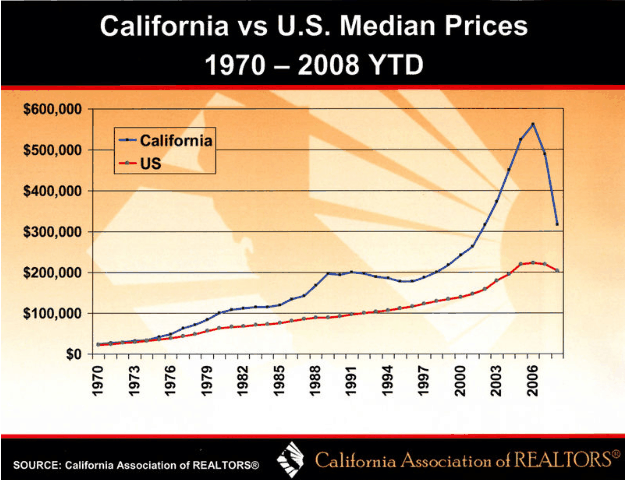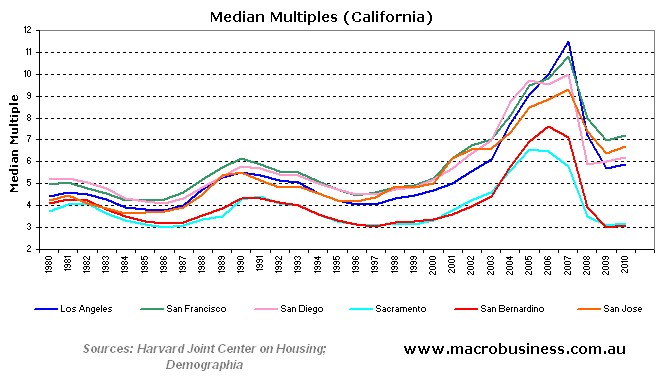
Let’s take a trip down memory lane. It’s early 2006 and the median house price in Los Angeles-Orange County, California has hit $582,000. Demographia has just released its latest International Housing Affordability Survey showing that Southern California has the most expensive housing market out of the six nations surveyed.
Property speculation is at fever pitched. Having watched others amass fortunes ‘flipping’ houses, first time ‘investors’ are entering the Californian real estate market en masse with the expectation of striking pay dirt. First time buyers, too, are rushing into the market before they are priced-out forever.
With some of the strictest land-use regulations in the United States, Californian housing supply is unable to keep up with the surging demand, creating claims of a chronic housing shortage that fuels expectations that prices will continue rising. Then, on 9 February 2006, the following article appears in a popular local newspaper:
The California Building Industry Association (CBIA) continues to express alarm over what it calls an ongoing housing crisis in Southern California.
Alan Nevin, the association’s chief economist, projected in a 2006 CBIA Housing Forecast that only 185,000 to 205,000 building permits will be granted this year, far short of the 240,000 new homes needed each year.
Southern California has been experiencing a massive population boom in recent years and it’s believed that 6 million new residents will be living in the region by 2020. The population increase, coupled with the housing shortage, has the CBIA worried that it will be increasingly difficult for first-time homebuyers to find a moderately priced unit.
“Los Angeles and Ventura counties are suffering from a housing crisis,” said Holly Schroeder, chief executive officer of the Building Industry Association Greater Los Angeles Ventura Chapter. “While we have seen increases in permitting, it still consistently falls far below the needs of our region. We have to find a way to take care of our own and provide housing to those that need it and want it”…
“In some cases, it can take nearly a decade to get new housing projects approved.That’s longer than it takes a pharmaceutical company to bring a drug to market,” Schroeder said. “The real question facing Southern California is how do we propose to help families realize the American dream and provide housing for the current and future generations living in California?”.
The 2006 forecast published by the California Association of Realtors paints a similar a picture to that of the CBIA… A 10 percent increase in the median price is predicted for a California home, the association said. Next year, the average home price in California is predicted to hit $573,000.
Officials are worried locally as well. “We are concerned that a lack of sufficient housing is causing prices to grow exponentially,” said Gary Wartik, economic development manager for the city of Thousand Oaks…
Back to reality:
The situation that I described above represents the prevailing mood in California in early 2006. The housing market was still buoyant and the mainstream view was that prices would continue rising on the back of the ‘chronic housing shortage’ that had developed following years of anemic new home construction.

How things change. Dr Housing Bubble last week published an article on the large increase in vacant homes in California following the recent housing crash.
In 2000 roughly 5.8 percent of all California housing units were listed as vacant. With the latest 2010 Census figures California is now listed as having 8 percent of all housing units vacant…
It might come as a surprise to many that California has 1.1 million vacant housing units. Back in 2000 California had 712,000 vacant units so over the decade we have increased the number of vacant units by 54 percent. At the same time. total housing units have increased by 11 percent…
Nationwide the median home price is approximately $160,000 while the nationwide household income is $50,000. Home prices nationally are 3.2 times the annual household income… In California prices are still out of balance with household incomes [see below chart]. The high leverage loans have been pulled from these markets allowing people to borrow 9 times their annual household income (or even higher in many cases)… [Although] Lower priced counties like San Bernardino [and Sacramento] are quickly approaching the pre-bubble price range…

How California’s shortage turned into surplus:
‘Underlying demand’ (or ‘pent-up’ demand) is the common methodology used in calculating whether there is a housing shortage. Put simply, underlying demand estimates what the demand for newly-built housing might be given the growth in population, trends in household size, demand for second (or holiday) homes, and economic conditions (e.g. employment, interest rates, etc). Underlying demand differs from ‘effective (actual) demand’, which is the quantity that owner-occupiers, investors and renters are actually able and willing to buy or rent in the housing market.
General economic conditions can dramatically affect the level of housing demanded. For instance, as economic conditions deteriorate, and unemployment rises, the number of people per dwelling will rise as they group together to reduce their housing costs. This most likely explains the current situation in California where, despite experiencing a chronic housing shortage (as measured by underlying demand) prior to the onset of the financial crisis, there is now a large oversupply of housing brought about by a deep recession.
Unresponsive supply cuts both ways:
The economic reality is that the demand for housing is changeable depending, largely, on the prevailing economic conditions. And when housing supply is unresponsive (‘inelastic’), these changes in demand feed directly into prices instead of new construction, making the housing market more volatile and prone to boom/bust cycles.
Nowhere is this more evident than in California, where strict land-use policies severely limits new home construction. In the lead up to the financial crisis, California’s unresponsive supply ensured that the extra demand caused by prolificate lending fed into higher prices instead of new construction. In turn, the price rises and perceived scarcity encouraged speculative demand and ‘panic buying’ from first-time buyers, which helped to drive prices up even further.
However, once the Californian economy began to deteriorate in 2007, demand evaporated causing prices to crash. The same supply dynamics that drove the market ever higher cut just as deeply on the way down.
Think about California the next time an ‘expert’ claims that Australia’s so-called housing shortage would prevent house prices from falling here.
Cheers Leith

